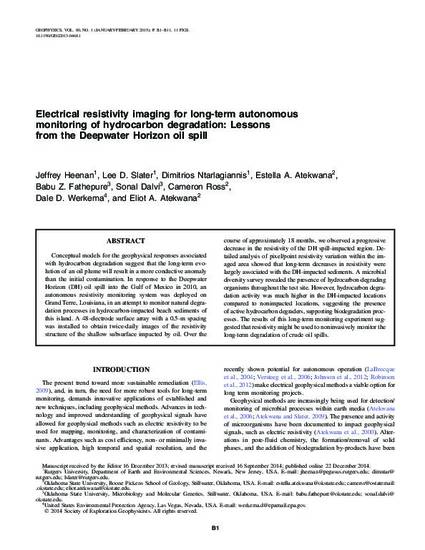
Conceptual models for the geophysical responses associated with hydrocarbon degradation suggest that the long-term evolution of an oil plume will result in a more conductive anomaly than the initial contamination. In response to the Deepwater Horizon (DH) oil spill into the Gulf of Mexico in 2010, an autonomous resistivity monitoring system was deployed on Grand Terre, Louisiana, in an attempt to monitor natural degradation processes in hydrocarbon-impacted beach sediments of this island. A 48-electrode surface array with a 0.5-m spacing was installed to obtain twice-daily images of the resistivity structure of the shallow subsurface impacted by oil. Over the course of approximately 18 months, we observed a progressive decrease in the resistivity of the DH spill-impacted region. Detailed analysis of pixel/point resistivity variation within the imaged area showed that long-term decreases in resistivity were largely associated with the DH-impacted sediments. A microbial diversity survey revealed the presence of hydrocarbon-degrading organisms throughout the test site. However, hydrocarbon degradation activity was much higher in the DH-impacted locations compared to nonimpacted locations, suggesting the presence of active hydrocarbon degraders, supporting biodegradation processes. The results of this long-term monitoring experiment suggested that resistivity might be used to noninvasively monitor the long-term degradation of crude oil spills.
- Biodegradation,
- Biology,
- Crude Oil,
- Hydrocarbons,
- Imaging Techniques,
- Long Term Evolution (LTE),
- Marine Pollution,
- Autonomous Monitoring,
- Biodegradation Process,
- Deepwater Horizon Oil Spills,
- Electrical Resistivity Imaging,
- Hydrocarbon Degradation,
- Hydrocarbon Degraders,
- Resistivity Structure,
- Resistivity Variation,
- Oil Spills,
- Electrical Resistivity,
- Environmental Impact,
- Environmental Monitoring,
- Hydrocarbon,
- Imaging Method,
- Microbiology,
- Oil Spill,
- Sediment Pollution,
- Atlantic Ocean,
- Gulf Of Mexico
Available at: http://works.bepress.com/estella-atekwana/22/